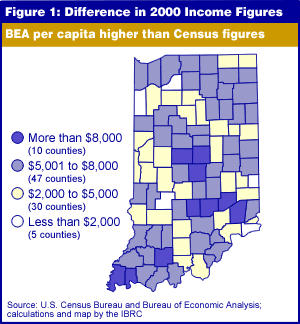Per Capita Income Confusion for Counties
One of the most commonly used economic indicators for local economies—per capita income—can cause considerable confusion among users. Why? Because there is more than one set of figures and they aren't the same nor are they issued by the same federal agency.
The two most commonly used are per capita money income and per capita personal income. Usually the figure is simply referred to as per capita or per capita income, and therein begins the confusion. Add to that the generally held notion that the Census produces all data, and we have added more confusion.
Per capita personal income is derived from total personal income, which is generally considered the more comprehensive measure. This can be seen directly in the county map showing the dollar difference between the Census 2000 measure and the 2000 annual estimate from BEA (see Figure 1).

The BEA estimate is higher in all 92 counties, and considerably higher by thousands of dollars in some (particularly Boone and Dubois counties). The differences in the way each of these measures—the one annual from the BEA and the other every ten years from the Census Bureau—also effects the relative rankings of the counties. Careful reading of the following agencies' definitions will help clarify these differences.
Per Capita Personal Income (PCPI)
- Source: U.S. Bureau of Economic Analysis
- Frequency: Annual for counties; quarterly for the states and the U.S.
- Time series: 1929 forward for U.S. and states; 1969 forward for counties and MSAs
- The sum of wage and salary disbursements and other labor income; proprietors' income with inventory and capital consumption adjustments; rental income of persons with capital consumption adjustment; personal dividend income; personal interest income; and transfer payments to persons, less personal contributions for social insurance. These measures include incomes of individuals, nonprofit institutions that primarily serve individuals, private noninsured welfare funds and private trust funds. Proprietors' income is treated in its entirety as received by individuals. Life insurance carriers and noninsured pension plans are not counted as persons, but their income and savings are credited to persons.
Per Capita Income
- Source: U.S. Census Bureau
- Frequency: Every 10 years
- Time series: Every Census since 1790
- Consists of cash and its equivalents received by individuals. It is the sum of the amounts reported separately for wage or salary income; net self-employment income; interest, dividends, or net rental or royalty income or income from estates and trusts; social security or railroad retirement income; Supplemental Security Income (SSI); public assistance or welfare payments; retirement, survivor or disability pensions; and all other income. It excludes: capital gains, money received from the sale of property (unless the recipient was engaged in the business of selling such property); the value of income in kind from food stamps, public housing subsidies, medical care, employer contributions for individuals, withdrawal of bank deposits; money borrowed; tax refunds; exchange of money between relatives living in the same household; and gifts and lump-sum inheritances, insurance payments and other types of lump-sum receipts.
Carol O. Rogers
Associate Director, Indiana Business Research Center,
Kelley School of Business, Indiana University
